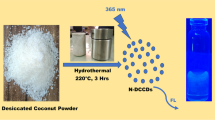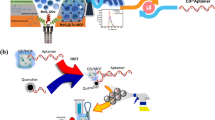Abstract
The authors describe the synthesis of fluorescent coral-like carbon nano-branched polymers (PCNBPs) co-doped with nitrogen and phosphorus. Uric acid and phosphoric acid act as nitrogen and phosphorus sources, respectively. The PCNBPs have a coral-like branched structure, are cross-connected, and < 20 nm in skeleton diameter. Their blue fluorescence, best measured at excitation/emission wavelengths of 330/425 nm, is quenched by mercury (II) ions due to the specifically restricted rigid conformation caused by the interaction of phosphorus, nitrogen, and oxygen groups on the surface of the PCNBPs. Fluorescence is selectivity quenched by Hg(II) but restored in addition of the hypertension drug captopril (CAP) in the range 50 nM to 40 μM concentration range. Fluorescence recovery is attributed to the effectively specific interactions between the thiol group of CAP and Hg(II). The method was applied to the determination of the concentration of Cap in pharmaceutical samples, and recoveries were between 97.6 and 105.1%.

Fluorescent coral-like carbon nano-branched polymers (PCNBPs) co-doped with nitrogen and phosphorus are described. Their fluorescence is selectivity quenched by Hg(II) but restored in addition of the hypertension drug captopril (Cap) in the range 50 nM to 40 μM concentration range.







Similar content being viewed by others
References
Dickinson BA, Semus HM, Montgomery RL, Stack C, Latimer PA, Lewton SM, Lynch JM, Hullinger TG, Seto AG, van Rooij E (2013) Plasma microRNAs serve as biomarkers of therapeutic efficacy and disease progression in hypertension-induced heart failure. Eur J Heart Failure 15:650–659
Lin PP, Hsieh YM, Kuo WW, Lin YM, Yeh YL, Lin CC, Tsai FJ, Tsai CH, Huang CY, Tsai CC (2013) Probioticfermented purple sweet potato yogurt activates compensatory IGFIR/PI3K/Akt survival pathways and attenuates cardiac apoptosis in the hearts of spontaneously hypertensive rats. Int J Mol Med 32:1319–1328
Romankiewicz JR, Brogden R, Heel RC, Speight TS, Avery GA (1983) Captopril: an update review of its pharmacological properties and therapeutic efficacy in congestive heart failure. Drugs 25:6–40
Gimenes DT, Marra MC, de Freitas JM, Abarza Muñoz RA, Richter EM (2015) Simultaneous determination of captopril and hydrochlorothiazide on boron-doped diamond electrode by batch injection analysis with multiple pulse amperometric detection. Sens. Actuators B: Chem. 212:411–418
Soomro RA, Tunesi MM, Karakus S, Kalwar N (2017) Highly sensitive electrochemical determination of captopril using CuO modified ITO electrode: the effect of in situ grown nanostructures over signal sensitivity. RSC Adv 7:19353–19362
Abbasi-Ahd A, Shokoufi N, Kargosha K (2017) Headspace single-drop microextraction coupled to microchipphotothermal lens microscopy for highly sensitive determination of captopril in human serum and pharmaceuticals. Microchim Acta 184:2403–2409
Absalan G, Akhond M, Karimi R, Ramezani AM (2018) Simultaneous determination of captopril and hydrochlorothiazide by using a carbon ionic liquid electrode modified with copper hydroxide nanoparticles. Microchim Acta 185:97
Lima MJA, Fernandes RN, Tanaka AA, Reis BF (2016) Development of a new procedure for the determination of captopril in pharmaceutical formulations employing chemiluminescence and a multicommuted flow analysis approach. Luminescence 31:288–294
Xiao SJ, Zhao XJ, Chu ZJ, Xu H, Liu GQ, Huang CZ, Zhang L (2017) New off-on sensor for captopril sensing based on photoluminescent MoOx quantum dots. ACS Omega 2:1666–1671
Perez JDR, Mecking S (2017) Anisotropic polymer nanoparticles with tunable emission wavelengths by intersegmental chain packing. Angew Chem Int Ed 56:1
Toloza CAT, Khan S, Silva RLD, Romani EC, Freire FL, Aucélio RQ (2016) Different approaches for sensing captopril based on functionalized graphene quantum dots as photoluminescent probe. J Lumin 179:83–92
Wang ZX, Ding SN (2014) One-pot green synthesis of high quantum yield oxygen-doped, nitrogen-rich, photoluminescent polymer carbon nanoribbons as an effective fluorescent sensing platform for sensitive and selective detection of silver (I) and mercury (II) ions. Anal Chem 86:7436–7445
Wang ZX, Yu XH, Li F, Kong FY, Lv WX, Wang W (2018) Multiplexed ratiometric photoluminescent detection of pyrophosphate by anisotropic boron-doped nitrogen-rich carbon rugby-like nanodots. J Mater Chem B 6:1771–1781
Wang ZX, Kong FY, Wang W (2017) Near-ultraviolet fluorescent “ON-OFF-ON” switching sensors based on nitrogen-enriched dual-color single-functional polymer carbon nanosheets. Chem.-Eur. J. 23:665
Gao B, Zhao F, Miao Y, Min H, Xu L, Huang C (2017) Boron- and nitrogen-doped photoluminescent polymer carbon nanoparticles as nanosensors for imaging detection of Cu2+ and biothiols in living cells. RSC Adv 7:47654–47661
Zheng XT, Ananthanarayanan A, Luo KQ, Chen P (2015) Glowing graphene quantum dots and carbon dots: properties, syntheses, and biological applications. Small 11:1620–1636
Saberi Z, Rezaei B, Faroukhpour H, Ensafi AA (2018) A fluorometric aptasensor for methamphetamine based on fluorescence resonance energy transfer using cobalt oxyhydroxide nanosheets and carbon dots. Microchim Acta 185:303
Munoz J, Navarro-Senent C, Crivillers N, Mas-Torrent M (2018) Study of carbon nanotube-rich impedimetric recognition electrode for ultra-low determination of polycyclic aromatic hydrocarbons in water. Microchim Acta 185:255
Fang Y, Guo S, Li D, Zhu C, Ren W, Dong S, Wang E (2012) Easy synthesis and imaging applications of cross-linked green fluorescent hollow carbon nanoparticles. ACS Nano 6:400–409
Song W, Duan W, Liu Y, Ye Z, Chen Y, Chen H, Qi S, Wu J, Liu D, Xiao L, Ren C, Chen X (2017) Ratiometric detection of intracellular lysine and pH with one-pot synthesized dual emissive carbon dots. Anal Chem 89:13626–13633
Ananthanarayanan A, Wang Y, Routh P, Sk MA, Than A, Lin M, Zhang J, Chen J, Sun HD, Chen P (2015) Nitrogen and phosphorus co-doped graphene quantum dots: synthesis from adenosine triphosphate, optical properties, and cellular imaging. Nanoscale 7:8159–8165
Guo S, Deng Z, Li M, Jiang B, Tian C, Pan Q, Fu H (2016) Phosphorus-doped carbon nitride tubes with a layered micro-nanostructure for enhanced visible-light photocatalytic hydrogen evolution. Angew. Chem., Int. Ed. 55:1830
Shi B, Su Y, Zhang L, Huang M, Liu R, Zhao S (2016) Nitrogen and phosphorus co-doped carbon nanodots as a novel fluorescent probe for highly sensitive detection of Fe3+ in human serum and living cells. ACS Appl Mater Inter 8:10717–10725
Dong X, Su Y, Geng H, Li Z, Yang C, Li X, Zhang Y (2014) Fast one-step synthesis of N-doped carbon dots by pyrolyzing ethanolamine. J Mater Chem C 2:7477–7481
Prasad KS, Pallela R, Kim DM, Shim YB (2013) Microwave-assisted one-pot synthesis of metal-free nitrogen and phosphorus dual-doped nanocarbon for electrocatalysis and cell imaging. Part Part Syst Charact 30:557–564
Hart JN, May PW, Allan NL, Hallam KR, Claeyssens F, Fuge GM, Ruda M, Heard PJ (2013) Towards new binary compounds: synthesis of amorphous phosphorus carbide by pulsed laser deposition. J Solid State Chem 198:466–474
Sun XC, Brückner C, Lei Y (2015) One-pot and ultrafast synthesis of nitrogen and phosphorus co-doped carbon dots possessing bright dual wavelength fluorescence emission. Nanoscale 7:17278–17282
Wang ZX, Yu XH, Li F, Kong FY, Lv WX, Fan DH, Wang W (2017) Preparation of boron-doped carbon dots for fluorometric determination of Pb (II), cu (II) and pyrophosphate ions. Microchim Acta 184:4775–4783
Zhang B, Liu CY, Liu Y (2010) A novel one-step approach to synthesize fluorescent carbon nanoparticles. Eur J Inorg Chem 2010:4411–4414
Huang X, Meng J, Dong Y, Cheng Y, Zhu C (2010) Polymer-based fluorescence sensors incorporating chiral binaphthyl and benzo[2,1,3] thiadiazole moieties for Hg2+ detection. Polym Sci Pol Chem 48:997–1006
Wang ZX, Kong FY, Wang WJ, Zhang R, Lv WX, Yu XH, Pan HC, Wang W (2017) “OFF-ON” sensor for detecting heparin based on Hg2+-quenching of photoluminescence nitrogen-rich polymer carbon nanoribbons. Sens Actuators B: Chem 242:412–417
Zhou L, Lin Y, Huang Z, Ren J, Qu X (2012) Carbon nanodots as fluorescence probes for rapid, sensitive, and label-free detection of Hg2+ and biothiols in complex matrices. Chem Commun 48:1147–1149
Sydlik SA, Chen ZH, Swager TM (2011) Triptycene polyimides: soluble polymerswith high thermal stability and low refractive indices. Macromolecules 44:976–980
Jung JM, Kim C, Harrison RG (2018) A dual sensor selective for Hg2+ and cysteine detection. Sens. Actuators B: Chem. 255:2756–2763
Xue L, Liu Q, Jiang H (2009) Ratiometric Zn2+ fluorescent sensor and new approach for sensing Cd2+ by ratiometric displacement. Org Lett 11:3454–3457
Acknowledgements
We greatly appreciate the support of the National Natural Science Foundation of China (21705140, 21575123, 21675139, 21603184) and the Natural Science Foundation of Jiangsu Province (BK20170474), and sponsored by Qing Lan Project and the Innovative Research Project of Key Laboratory of Functional Inorganic Material Chemistry, Ministry of Education. The opening project of Jiangsu Key Laboratory of Biochemistry and Biotechnology of Marine Wetland (K2016-17, K2016-20).
Author information
Authors and Affiliations
Corresponding author
Ethics declarations
The author(s) declare that they have no competing interests.
Electronic supplementary material
ESM 1
(DOC 621 kb)
Rights and permissions
About this article
Cite this article
Wang, ZX., Gao, YF., Yu, XH. et al. Photoluminescent coral-like carbon-branched polymers as nanoprobe for fluorometric determination of captopril. Microchim Acta 185, 422 (2018). https://doi.org/10.1007/s00604-018-2961-9
Received:
Accepted:
Published:
DOI: https://doi.org/10.1007/s00604-018-2961-9




